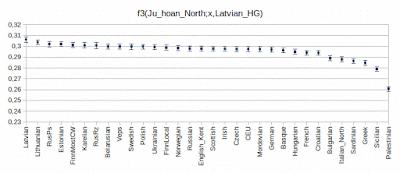Because we know very little about the time before the Migration Period in Finland, let's start from it. Here are some professional views, made by non-Finnish scientists. At first a two-piece video document of Swedish production about Baltic Sea Vikings, touching also Finns.
https://www.svtplay.se/video/16169343/ostersjofinnarna/ostersjofinnarna-sasong-1-avsnitt-1
https://www.svtplay.se/video/16169303/ostersjofinnarna/ostersjofinnarna-sasong-1-avsnitt-2?start=auto
What is interesting is how they see the beginning of Finnish settlements. Six screenshots show how ancient Finnish settlements spread across Southern Finland and continued to the Lake Ladoga. The presentation doesn't show the whole picture. Our genes and language imply that they went much further to the east, at least to the Lake Onega in Northern Russia. There is also an open question about Southern Finland. Until now scientists have supposed that Southern Finland around our present-day capital town was uninhabited to the Swedish era. New archaeological finds can change the history and also explain a new straight route from Southwest Finland to Karelia. Anyway there must have been a southern route to Viking Age Ladogan settlements and Staraja Ladoga/Aldeigjuborg.
The scientific view is clear, the migration flow during the first millennium was from west to east, not from east to west.
Here is another view, a German one from Wikipedia, showing Viking settlements. No matter how we interpret Vikings, we sure can't consider that all Scandinavians were Vikings, neither all Finns or none of them, but here we have a view about Viking Age settlements linked together. Note that Ostrobothnia is considered as a Viking settlement. In some sources it is assumed to have had a Swedish-Saami settlement, disappearing during the Viking Age.
German studies written by Steuer give more information about archeology and evidences about settlements during the Migration period and the Vendel era.
Ring swords
Counterweight of silver scale in the late Viking Age. It is amazing how many counterweights in purpose to weight silver coins have been found in Finland, especially in comparison to its small population. The Finnish population was much smaller than the Swedish one and even smaller than in Estonia. In Estonia it was around three or four times bigger than in Finland. Only after Northern Crusades the arrangement changed and little by little the number of Finns grew while Estonians suffered from its colony status.
Counterweight
A German book "Die Wikinger", written by Brenda Ralph Lewis, Hildegard Elsner and Nikolai Smirnov locates the heartland of Vikings.
All above was presented as an introduction to my genetic work. Although the view shown above is anything but perfect and especially some Viking Age settlements can be criticized, it is clear that scientists can't fabricate the history and lie about the migration direction. It is reasonable to note that my work follows the scientific view.
My new tests are based on 800000 SNP's, 744 samples and globally 104 populations. The data was haplotyped using newest available reference data from the 1000 genomes project and Shapeit software. Haplotype data was processed using Chromopainter V2 in two steps, the first step to define run parameters, and the result is reported using Globetrotter. Results show the best present day fit of selected population using all 103 populations as donors.
Finnish samples, 99 individuals from the 1000 genomes project are grouped into four groups using self-reporting of my project members. We see that the Finns can be defined internally with exception of the group 1, which can define other Finnish groups. Nothing points to migrations from east, even though the data is global.
Finnish group 1
Finnish2 0,408
Scandinavian 0,262
Finnish3 0,245
Slavic 0,036
Near-East 0,018
Mari_Chuvash 0,012
Finnish group 2
Finnish4 0,567
Finnish1 0,378
Finnish3 0,054
Finnish group 3
Finnish4 0,783
Finnish2 0,217
Finnish group 4
Finnish3 0,738
Finnish2 0,262
Karelian-Vepsa (Eastern Baltic-Finns)
Finnish4 0,373
Baltic 0,307
Finnish2 0,212
Mari_Chuvash 0,062
Saami 0,017
Mordvas
Slavic 0,516
Tatar 0,195
Karelian_Vepsa 0,122
Baltic 0,058
Mari_Chuvash 0,043
Caucasian 0,011
Mari-Chuvash
Tatar 0,406
Mordva 0,256
Bashkir 0,170
Khanti-Mansi 0,090
North_Siberian 0,018
Karelian_Vepsa 0,013
Tungusic 0,011
Scandinavians (academic Swedish samples)
West_Europe 0,573
Finnish2 0,164
Baltic 0,162
Finnish1 0,058
Finnish3 0,031
Finnish 1 includes 26,2%, Finnish2 9,9% and Finnish3 2,1% Swedish ancestry.
Control results
British Isles 1 (Kent)
British_Isles3 0,487 (Scottish)
West_Europe 0,453
British_Isles2 0,057 (Cornwall)
Bosnia-Hertsegovina Romas
Armenian 0,375
South_Asian 0,224
Balkan 0,195
Slavic 0,122
Near-East 0,021
Caucasian 0,017
Central_Asian 0,017

















































